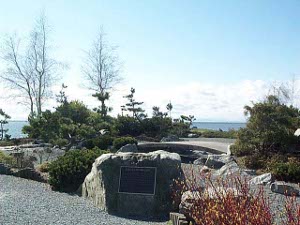 Garry Point Park
Garry Point Park
Today the sun shone with only a bit of clouds, a good day for errands and outdoor sightseeing. Our first stop was the Surrey Wal-Mart, the first two-story one we've seen (a Movator carries shoppers and their shopping carts down an incline to Hardware, Clothing and Pharmacy).
 Garry Point Park
Garry Point Park
We stopped at the Serpentine Fen wildlife refuge, but didn't see many water birds; probably the wrong season. The sign told us this sanctuary was built by Ducks Unlimited and paid for by Northern California Sportsmen, so we imagine our friend Dr. King had a hand in this one!
We drove through the Delta of the Fraser River, which was rich farmland, to the fishing village of Steveston. Our first stop was Garry Point Park at the water's edge.
Families were flying airplane-shaped kites in the spring breeze, and walkers were moving briskly. A small Japanese garden honors the first Japanese immigrant to Vancouver, about 100 years ago. Right on the shore is a striking memorial to fishermen lost at sea. A large metal net-mending needle symbolizes the fisherman's crafts, along with two compass roses -- true and magnetic. The names of almost 200 fishermen and their boats are inscribed in the black marble base; they were lost at sea in the past century. It reminded us a little of the coal miner's memorial on Cape Breton; just earning a living could be terribly dangerous.
 Steveston Fishing Fleet
Steveston Fishing Fleet
The Gulf of Georgia Cannery, a National Historic Site in Steveston, won't open until next month, but the shops and restaurants were open for business. Steveston itself reminded us a little of Ports of Call Village in Los Angeles, with lots of little stores and restaurants overlooking the fishing harbor.
Our last sight of the day was a huge Chinese Buddhist Temple. We visited the extensive grounds, with an adjacent vegetable farm -- practicing Buddhists are vegetarians, as they believe humans can be reincarnated as animals, and vice-versa. Surprisingly, this elaborate temple was started just 20 years ago; construction is continuing on more buildings for study and worship. Lots of the faithful, many of them young, were burning incense and praying before numerous small shrines. Tracts were available in Chinese and English, and a number of the worshippers were Caucasians.
We removed our shoes to enter the Main Gracious Hall, where offerings of food and fruit were placed in front of each statue. Little tablets lined the wall for individuals to pay respect to their ancestors. Worshippers entered and prayed at each of the shrines in order, kneeling on padded stools. A store was busily selling incense and religious objects.
 Buddhist temple
Buddhist temple
Some of the shrines are to different Buddhisattvas, individuals who attained nirvana through meditation. The Ksitigarbha Buddhisattva assists in ancestor worship; the Avalokitesvara Buddhisattva assists in matters of daily life, health, prosperity, or family well-being by interpreting oracles, and the Thousand-Hands Thousand-Eyes Avalokitesvara Buddhisattva will answer prayers and lend a helping hand to all those in need.
The entire temple site is the creation of the International Buddhist Society, providing services to the large, and growing, number of Buddhists in the Vancouver area. As we toured the temple we thought about the words of Francis Fukuyama, who notes that Chinese society is highly family-oriented, and does not readily encompass trust for strangers. We also thought of our visits to churches and synagogues in Europe and America; the flamboyant Chinese architecture provided a vivid contrast to gothic and romanesque cathedrals (which perhaps have their own Western flamboyance).
Although Canada is officially bilingually English and French, here in Vancouver the second language is definitely Chinese; not only street and restaurant signs, but the usual No Public Restrooms and Pay Parking and Special Bargain notices are in English and Chinese. Chinese newspapers abound. We're rapidly realizing that we are in one of the most culturally rich cities we've visited so far.